
Helianthemum nummularium (L.) Mill.
Fam. : Cistaceae
© Pascale SERVAIS & Pierre SEBA, 2018. Tilo Botanica: Flore de Tilos et du Dodécanèse / Flora of Tilos and of the Dodecanese
English translation by Brenda Bradbury, Howard Bradbury and Stéphane Léonard
Sous-arbrisseau hermaphrodite, prostré à ascendant, à tiges peu nombreuses, poilues.
Feuilles opposées, simples, linéaires à lancéolées, verdâtres dessus, à poils gris ou blanchâtres dessous, à bords plats ou légèrement enroulés, à petites stipules foliacées plus longues que le pétiole.
Fleurs à symétrie radiaire, jaune pâle à jaune vif, de 10 à 18 mm de diamètre, portées par un pédicelle de 1 cm environ, réunies en grappes lâches, unilatérales, de 4 à 8 cm de long. Calice à 5 sépales rayés de vert, poilus, les deux externes plus petits. Nombreuses étamines, toutes fertiles, à filet jaune et anthère orange. 1 style jaune et 1 stigmate. Ovaire supère.
Fruits, capsules pendantes à 3 valves, presque aussi longues que les sépales.
___________________________
Shrublet hermaphrodite, prostrate to ascending. Stems few, hairy.
Leaves opposite, simple, linear to lanceolate, greenish above, with grey or whitish hairs below, with flat or slightly coiled edges, with small foliaceous stipules longer than the petiole.
Flowers radially symmetrical, pale yellow to bright yellow, from 10 to 18 mm in diameter, carried by a pedicel approximately 1 cm, joined together in loose, unilateral racemes, from 4 to 8 cm long. Calyx with 5 sepals striped of green, hairy, the two external ones smaller. Numerous stamens, all fertile, with a yellow filament and an orange anther. 1 yellow style and 1 stigma. Ovary superior.
Fruits, hanging capsules with 3 valves, almost as long as the sepals.
Descripteurs / Identifying features
1
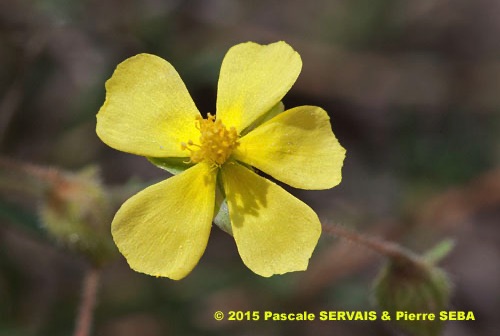
2
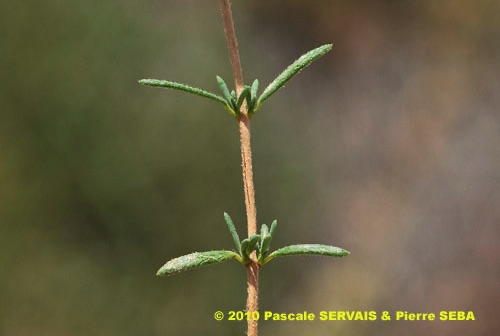
3
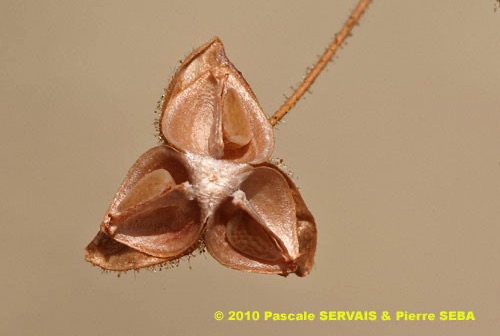
4
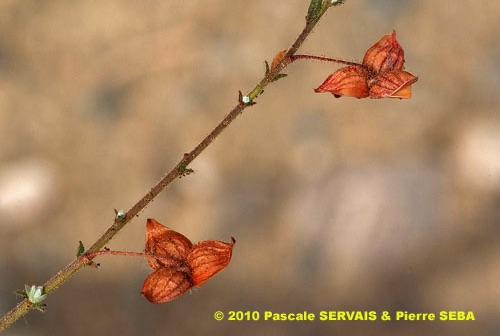
5
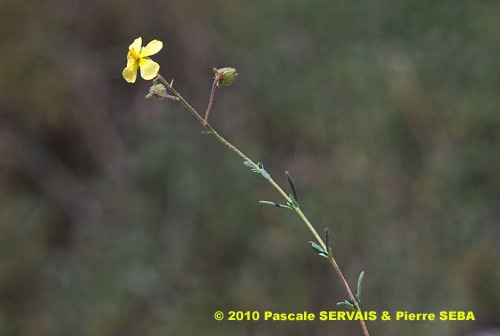
6
Étymologie / Etymology :
Helianthemum : nom créé par les botanistes [ < ἥλιος, -ου (nom)
= le soleil + ἄνθεμον, -ου (nom) = la fleur ], en référence aux fleurs
jaunes qui se tournent vers le soleil.
Nummularium : emprunt du latin nummularius, -a, -um (adj.)
[ < nummus, -i (nom) = l’argent, la monnaie ] = qui concerne les
pièces de monnaie, en référence à la forme des feuilles chez
certaines espèces.
Helianthemum : name created by botanists [ < ἥλιος, -ου (noun)
= sun + ἄνθεμον, -ου (noun) = flower ], referring to the yellow flowers
that turn towards the sun.
Nummularium : borrowed from Latin nummularius, -a, -um (adj)
[ < nummus, -i (noun) = money ] = which relates to the coins,
referring to the shape of some species.
Synonymes / Synonyms :
Cistus barbatus Lam.
Cistus dubius Pourr.
Cistus nummularius L.
Cistus serpillifolius L.
Helianthemum angustipetalum Cadevall
Helianthemum barrelieri Ten.
Helianthemum chamaecistus subsp. nummularium (L.) Grosser
Helianthemum chamaecistus subsp. vulgare (Gaertn.) Cout.
Helianthemum germanicum Mill.
Helianthemum graecum Boiss. & Heldr.
Helianthemum nummularium subsp. nummularium
Helianthemum nummularium subsp. vulgare (Gaertn.) Hayek
Helianthemum sampsuchifolium Mill.
Helianthemum variabile Spach
Helianthemum vulgare Gaertn.
Helianthemum vulgare proles scopolii Rouy & Foucaud
Helianthemum vulgare subsp. fontis-romaei Sennen
Helianthemum vulgare subsp. serpillifolium (L.) Nyman
Helianthemum vulgare var. heterophyllum Foucaud & Rouy
Helianthemum vulgare var. hirsutum Foucaud & Rouy
Helianthemum vulgare var. oblongifolium Foucaud & Rouy
Helianthemum vulgare var. ovalifolium (Willk.) Foucaud & Rouy
Noms vernaculaires / Common names :
Noms français / French names :
Hélianthème à feuilles arrondies — Hélianthème commun —
Hélianthème jaune — Hélianthème nummulaire —
Hélianthème tomenteux.
Noms grecs / Greek names :
Ηλιάνθεμο — Ηλιάνθεμον κίτρινο — Ηλιάνθεμον το κίτρινο.
Noms anglais / English names :
Common rock-rose — Sunrose.
Noms allemands / German names :
Filziges Sonnenröschen — Gemeines Sonnenröschen —
Gemeines-Sonnenröschen — Gewöhnliches Sonnenröschen —
Goldröschen — Sonnengünsel.
Nom espagnol / Spanish name :
Perdiguera.
Noms italiens / Italian names :
Eliantemo maggiore — Eliantemo tomentoso.
Habitat :
Jardins - Lieux pierreux - Lieux incultes - Chemins.
Gardens - Stony places - Waste ground - Waysides.
Île / Island :
Tilos.
Hauteur / Height range :
De 10 cm à 50 cm.
From 10 cm to 50 cm.
Floraison / Flowering time :
De janvier à mai.
From January to May.
Groupe / Classification :
Dicotylédones.
Dicotyledons.
Pérennité / Lifespan :
Vivace.
Perennial.
Description :
Clés dichotomiques et descripteurs distinctifs des 2 espèces / Dichotomous keys and distinctive identifying features of the 2 species
Photo 1 :
Localisation / Location : Tilos, Megalochorio, Plaine d’Erystos
Date : 13/05/2010
GPS : Lat. 36,43634° N / Long. 27,34354° E / Alt. 65 m
Type : Photographie numérique / Digital Photograph (10 mégapixels)
Photo 2 :
Localisation / Location : Tilos, Megalochorio, Plaine d’Erystos
Date : 13/05/2010
GPS : Lat. 36,43634° N / Long. 27,34354° E / Alt. 65 m
Type : Photographie numérique / Digital Photograph (10 mégapixels)
Photo 3 :
Localisation / Location : Tilos, Megalochorio, Plaine d’Erystos
Date : 13/05/2010
GPS : Lat. 36,43634° N / Long. 27,34354° E / Alt. 65 m
Type : Photographie numérique / Digital Photograph (10 mégapixels)
Photo 4 :
Localisation / Location : Tilos, Megalochorio, Plaine d’Erystos
Date : 13/05/2010
GPS : Lat. 36,43634° N / Long. 27,34354° E / Alt. 65 m
Type : Photographie numérique / Digital Photograph (10 mégapixels)
Photo 5 :
Localisation / Location : Tilos, Megalochorio, Plaine d’Erystos
Date : 13/05/2010
GPS : Lat. 36,43634° N / Long. 27,34354° E / Alt. 65 m
Type : Photographie numérique / Digital Photograph (10 mégapixels)
Photo 6 :
Localisation / Location : Tilos, Megalochorio, Plaine d’Erystos
Date : 13/05/2010
GPS : Lat. 36,43634° N / Long. 27,34354° E / Alt. 65 m
Type : Photographie numérique / Digital Photograph (10 mégapixels)

Google Maps
Google Maps
Google Maps
Google Maps
Google Maps
Google Maps